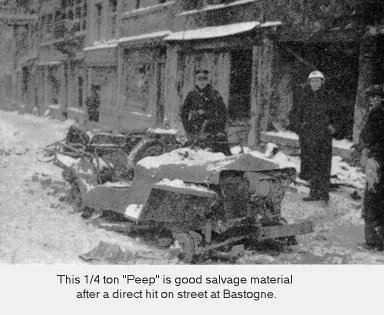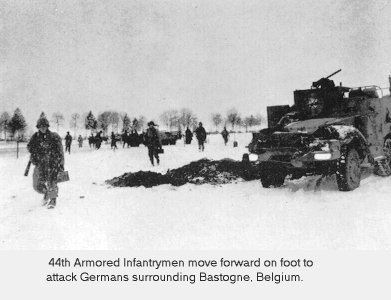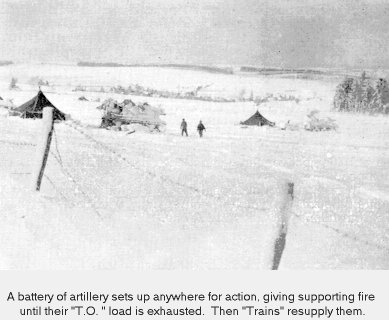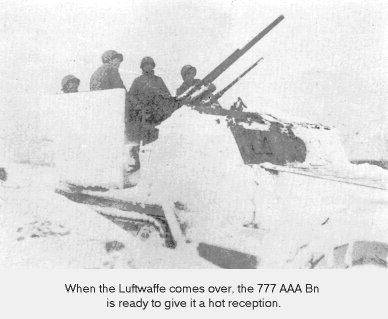Saar Campaign |
|
Dasburg-Prum River Campaign |
|
|
Chapter IV |
Saar Campaign |
|
Dasburg-Prum River Campaign |
|
|
Chapter IV |
 The ARDENNES
offensive was the biggest German effort since the Allies started their
campaign in Western Europe. On 16 December simultaneous attacks were
launched at five places along a 70-mile sector of the Western Front.
Enemy intelligence concerning our dispositions was, as usual, excellent.
The attack was directed at a part of the line in the north held by the
99th and 106th Infantry Divisions which were seeing their first action
and a front in the south held by the 28th and 4th Infantry Divisions which
had recently seen much action and had been placed in a quiet sector for
rest.
The ARDENNES
offensive was the biggest German effort since the Allies started their
campaign in Western Europe. On 16 December simultaneous attacks were
launched at five places along a 70-mile sector of the Western Front.
Enemy intelligence concerning our dispositions was, as usual, excellent.
The attack was directed at a part of the line in the north held by the
99th and 106th Infantry Divisions which were seeing their first action
and a front in the south held by the 28th and 4th Infantry Divisions which
had recently seen much action and had been placed in a quiet sector for
rest.
Against these fronts the Germans threw their elite SS Panzer Divisions with all available reserves, striking south of LIEGEand north and east of BASTOGNE with a total of 24 divisions. Supplies had been accumulated over a period of time and gasoline had been hoarded. The objective in the north was a drive to LIEGE to cut off the First and Ninth U. S. Armies with a possible objective of reaching ANTWERP; the objective in the south was a drive to the MEUSE and LUXEMBOURG. By 21 December the 116th Panzer Division was launching heavy attacks against the 101 Airborne Division in BASTOGNE, and in LUXEMBOURG, ETTELBRUCK had been captured. The 4th Armored Division began its drive north from ARLON toward the encircled city. The 6th Armored, now coming into METZ, was preparing to enter the battle after having been relieved in the FORBACH and SARREGUEMINES sector by the 103rd Infantry Division.
Upon the arrival of the final units of the Division in METZ on Christmas Day, the Division reorganized its combat commands, and headed north to relieve elements of the 10th Armored Division in the vicinity of MERSCH, LUXEMBOURG.
 Within
forty-eight hours, however, another swift change came into effect, and
the 6th Armored was withdrawn from the XII Corps and assigned to the III
Corps, with orders to assemble northwest of ARLON for future operations.
For two days, 29-30 December, the Division remained in the BELGIUM assembly
area, reorganizing combat command forces and maintaining vehicles and weapons.
Within
forty-eight hours, however, another swift change came into effect, and
the 6th Armored was withdrawn from the XII Corps and assigned to the III
Corps, with orders to assemble northwest of ARLON for future operations.
For two days, 29-30 December, the Division remained in the BELGIUM assembly
area, reorganizing combat command forces and maintaining vehicles and weapons.
With efforts to hold BASTOGNE appearing to be successful, and that terrain being more favorable for armored operations, the 6th Armored Division was rushed into the zone southeast of the city to attack. During this period, BASTOGNE was under constant enemy artillery shelling and nightly bombing attacks. The German high command was massing a strong force to the east and southeast of the city in an effort to cut off the BASTOGNE salient. Elements of Combat Command A moved forward during the hours of darkness, 31 December, and attacked the high ground in the vicinity of WARDIN, east of BASTOGNE, against strong enemy frontal and flank resistance.
New Year's Day sent two Combat Commands, A and B, attacking abreast to the northeast and east, with Combat Corrmand A on the right and Combat Command B on the left. Passing through the 501st Parachute Regiment, the Commands advanced northeast against determined enemy resistance, clearing the towns of NEFFE and BIZORY and occupying the town of MAGERET. Contact was maintained with the 101st Airborne Infantry Division on the left and the 80th Infantry Division on the right. This drive represented the first real offensive thrust into the flank of the ARDENNES salient. BASTOGNE,. now safe, was never seriously threatened again. In the late afternoon Corps orders broadened the zone to the right in the direction of BRAS. Such a broad objective forced the commitment of all reserves, so practically all the Division's combat strength was put in the two combat commands.
The men in the line fought in weather that had turned bitterly cold in their first engagement in the BASTOGNE sector. Snow, ice and sub-freezing weather provided the setting for one of the most severe campaigns ever fought by American troops. Tank turrets froze, and would not traverse until chipped free of ice. Iced breach blocks had to be manually operated. M-ls refused to function until bolts were beaten back and forth. Tank escape hatches and doors stuck fast and were opened by blow torches. Ice formed in gas tanks and clogged lines. And in fox holes, feet froze.
On 2 January, the Division advanced for a gain of approximately six
square miles, encountering savage resistance. Later, enemy counterattacks
of powerful infantry and tank formations were successful in driving our
forces out of MICHAMPS and repulsing an attack on ARLONCOURT. WARDIN
was entered, however, and the Division held firmly to the high ground west
of the line MICHAMPS - ARLONCOURT - WARDIN for the night.
XIX TAC fighter bombers worked in close support, hitting one ammunition dump, concentrations of enemy vehicles, columns on roads, enemy tanks and defended enemy towns.
After three days of bitter fighting and constant enemy counterattacks in deep snow and near-zero weather, the Division halted temporarily to consolidate its positions and secure much needed rest.
 Two combat
teams of Combat Command A made small gains in the vicinity of WARDIN and
fresh elements entered the line. The line at this time ran generally
south from the neighborhood of OUBOURCY along the edge of the woods a distance
of 1500 yards, then southeast across the BASTOGNE-LONGVILLY road where
it turned southwest through the BOIS ST LAMBERT, around the western edge
of WARDIN to the banks of the MARVIE and a junction with the 35th Infantry
Division. Plans at this time were to clear the large wooded pocket
southeast of BASTOGNE and destroy the large enemy concentration sheltered
there. The 6th was to continue attack toward LONGVILLY.
Two combat
teams of Combat Command A made small gains in the vicinity of WARDIN and
fresh elements entered the line. The line at this time ran generally
south from the neighborhood of OUBOURCY along the edge of the woods a distance
of 1500 yards, then southeast across the BASTOGNE-LONGVILLY road where
it turned southwest through the BOIS ST LAMBERT, around the western edge
of WARDIN to the banks of the MARVIE and a junction with the 35th Infantry
Division. Plans at this time were to clear the large wooded pocket
southeast of BASTOGNE and destroy the large enemy concentration sheltered
there. The 6th was to continue attack toward LONGVILLY.
For five days following, the enemy tank-infantry teams struck at the Division's line seeking a soft spot. Under the greatest of stress and strain the Division's troops withstood the German drives, turning them back each time with heavy personnel and vehicular losses.
On the 9th of January the tide was beginning to turn. Reinforced by
part of the 320th Regiment, 35th Infantry Division, the 6th Armored Division
pushed forward on an attack. Combat Command A attacked and captured
the high ground southeast of MARVIE, strengthening its tie-in with elements
of the 35th Infantry Division on its right which was reinforced by a loan
of tanks from the Division, while Combat Command B continued contact with
101 Airborne Division on the Division's left flank. On 10 January
the 4th Armored Division was inserted on a narrow front on the left to
attack through Combat Command B. The attack failed to make headway north
of MAGERET and in midafternoon, that Division was suddenly pulled back
into reserve while Combat Command B resumed defense of the line.
The attack to the east was resumed on 11 January with Combat Command A on the right making the initial drive. With the balance of the 320th Infantry attached on 12 January, the attack was continued day after day on the whole Division front. Cutting the BOURCY-LONGVILLY road, the Division's objective, was accomplished by 17 January, only after driving through severe enemy resistance. Enemy defenses in the Corps zone had weakened and crumbled on the 4th day bf the offensive. It was here, after nine long bitter-cold days, that the backbone of the German strength was broken. The towns of WARDIN, BENONCHAMPS, ARLONCOURT, OUBOURCY, LONGVILLY, and MICHAMPS had been taken.
By now the enemy had definitely lost the "Battle of the Bulge", and was concentrating all his efforts in fighting a savage rear guard action, hoping to get as much of his armor as possible back across the OUR River and behind the WESTWALL.
The 134th Infantry of the 35th Infantry Division relieved the 320th
Infantry on 18 January and continued attached to the Division for the balance
of the campaign.
Corps orders to attack to the east and northeast were received 20 January.
In the morning, 21 January, the Division's tank-infantry forces pushed
forward in their zones. Combat Command B on the left and Combat Command
A to its right. The Division, maintaining contact with the 90th Infantry
Division on the southern flank, and the llth Armored Division on the north
and rear, advanced approximately seven miles, capturing six towns and clearing
the greatly weakened and discouraged enemy from its zone. Constant
delays due to terrain difficulties, heavy snows and enemy delaying forces
hindered the speed of the attack. By dark, the towns of TROINE, BARAQUE
DE TROINE, GRENDAL, LULLANGE, HOFFELT and HACHIVILLE were captured by the
advancing armored force.
During the ARDENNES salient, the air corps was of tremendous help to the 6th Armored and other American forces. In the BELGIAN sector, on the single day of 22 January, the air force destroyed or damaged more than 4,192 pieces of heavy equipment, including locomotives, rail cars, tanks, and motor and horse-drawn vehicles.
 In spite
of mines and demolitions blocking the valley leading into TROIS VIERGES,
the Division's infantry and tanks worked into the city. Here the
attacking force was met by considerable fire of all types-small arms, mortar,
artillery and Nebelwerfer. Street fighting marked every thoroughfare.
TROIS VIERGES was cleared after dusk, 23 January, secured and outposted.
In spite
of mines and demolitions blocking the valley leading into TROIS VIERGES,
the Division's infantry and tanks worked into the city. Here the
attacking force was met by considerable fire of all types-small arms, mortar,
artillery and Nebelwerfer. Street fighting marked every thoroughfare.
TROIS VIERGES was cleared after dusk, 23 January, secured and outposted.
Under the cover of darkness, Combat Command A with great success attacked and captured the towns of HOLLER and BREIDFELD, 24 January. Its attack during the night proved a surprise to the enemy, and only light rear-guard action was encountered by the foot-troops.
A last ditch stand by the German defenders warded off the armored attack on the village of WEISWAMPACH on 25 January, but by early morning of 26 January the heavy artillery and antitank fire had been overcome, and the high ground east of the village was taken. Once this occurred, the German salient was wiped out completely. This plot of high ground astride SKYLINE DRIVE secured the Corps objective, and again placed the 6th Armored Division in a position where activity in Germany could be observed.
An exchange of divisional zones with the 90th Infantry Division placed
the 6th Armored to the right of the zone in which it had previously attacked.
By 27 January the Division had also relieved the 26th Infantry Division
in its zone.
Saar Campaign |
|
Dasburg-Prum River Campaign |
![]() Return
to 6th Armored home page.
Return
to 6th Armored home page.
NOTE: Remove question mark from email address below when sending email.
Page maintained by Bruce
Frederick
Last update: April 21, 1998 ![]()